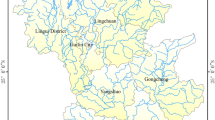Abstract
It is imperative to develop a risk assessment system for quickly predicting storm surge disaster due to the vulnerability of Tianjin Binhai New Area. The flood routing model with user-defined breaches was firstly established based on the seed spread algorithm in order to achieve a rapid forecasting of storm surge flood information. Furthermore, fuzzy mathematics was utilized to identify the storm disaster grade, and the hazard mapping was conducted to visually obtain the hazard spatial and temporal distribution. Finally, the flood routing visualization method was proposed based on numerical simulation of storm surge to achieve the reappearance scene of dynamic evolution process. The developed system can play a vital role in the management and decision-making of sea dyke mitigation engineering in Tianjin Binhai New Area.
Similar content being viewed by others
References
Chen Jian, Hill A A, Urbano L D. A GIS-based model for urban flood inundation[J]. Journal of Hydrology, 2009, 373(1): 184–192.
Taramelli A, Melelli L, Pasqui M et al. Modelling risk hurricane elements in potentially affected areas by a GIS system[J]. Geomatics, Natural Hazards and Risk, 2010, 1(4): 349–373.
Qi Honghai, Altinakar M S. A GIS-based decision support system for integrated flood management under uncertainty with two dimensional numerical simulations[J]. Environmental Modelling & Software, 2011, 26(6): 817–821.
Apivatanagul P, Davidson R, Blanton B et al. Long-term regional hurricane hazard analysis for wind and storm surge[J]. Coastal Engineering, 2011, 58(6): 499–509.
Condon A J, Sheng Y P. Optimal storm generation for evaluation of the storm surge inundation threat[J]. Ocean Engineering, 2012, 43: 13–22.
Muthusankar G, Lakshumanan C, Pradeep-Kishore V et al. Classifying inundation limits in SE coast of India: Application of GIS [J]. Natural Hazards, 2013, 65(3): 2401–2409.
Teng Junhua, Wu Wei, Sun Meixian et al. Aided decisionmaking information system based on GIS for disaster mitigation of storm surge[J]. Journal of Natural Disasters, 2007,16(2): 16–21(in Chinese).
Zhang Wenting, Zhang Xingnan, Liu Yongzhi et al. Study on storm tide induced flood risk analysis system based on GIS[J]. Water Resources and Power, 2008, 26(2): 44–47(in Chinese).
Zhang Wenting, Zhang Xingnan, Liu Yongzhi et al. Research on windstorm tide flood risk mapping[J]. Journal of Catastrophology, 2007, 22(2): 114–118(in Chinese).
Zheng Zongliang, Huang Dongmei, Zhang Jianxin et al. Storm disaster assessment geographic information system based on SOA[J]. Computer Engineering and Design, 2011, 32(3): 931–935(in Chinese).
Liu Donghai, Zuo Wentao, Wang Xiaoling et al. WebGISbased visual simulation of storm surge flood routing[J]. Journal of System Simulation, 2013, 25(5): 999–1004(in Chinese).
Zerger A, Smith D I. Impediments to using GIS for realtime disaster decision support[J]. Computers Environment and Urban Systems, 2003, 27(2): 123–141.
Blanton B, McGee J, Fleming J et al. Urgent computing of storm surge for North Carolina’s coast[J]. Procedia Computer Science, 2012, 9: 1677–1686.
JTJ 213-98. Code of Hydrology for Sea Harbour[S]. 1998(in Chinese).
Liu Renyi, Liu Nan. A GIS based model for calculating of flood area [J]. Acta Geographica Sinica , 2001, 56(1): 1–6(in Chinese).
Tong Dawei, Sun Yichao, Sun Ruirui et al. Comprehensive risk analysis of storm surge flood based on WebGIS[J]. Transactions of Tianjin University, 2012, 18(3): 194–200.
Zhang Xingnan, Luo Jian, Chen Lei. Zoning of Chinese flood hazard risk[J]. Journal of Hydraulic Engineering, 2000(3): 1–7(in Chinese).
Fang Hao, Li Shanfeng, Ye Xiaobin. The evaluation on economic loss caused by storm tides in Tianjin[J]. Marine Environmental Science, 2007, 26(3): 271–274(in Chinese).
Sun Zheng, Zhuang Li, Feng Qiming. Fuzzy cluster analysis-based storm surge disaster gradation[J]. Journal of Natural Disasters, 2007, 16(4): 49–54(in Chinese).
Author information
Authors and Affiliations
Corresponding author
Additional information
Supported by the National Basic Research Program of China (“973” Program, 2013CB035906) and National Natural Science Foundation of China (No. 51209159 and No. 51439005).
Rights and permissions
About this article
Cite this article
Cui, B., Zhou, Z., Wang, X. et al. System development for storm surge hazard assessment based on WebGIS for Tianjin Binhai New Area. Trans. Tianjin Univ. 22, 50–56 (2016). https://doi.org/10.1007/s12209-016-2564-7
Accepted:
Published:
Issue Date:
DOI: https://doi.org/10.1007/s12209-016-2564-7




